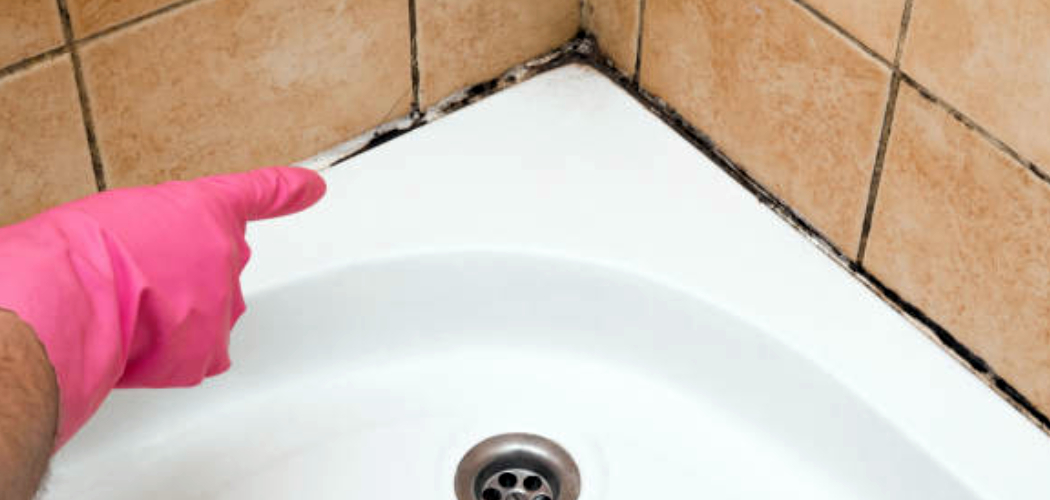Are you tired of wiping the walls and mirrors in your bathroom every time you take a shower? But don’t worry. There are simple steps you can take to prevent condensation in your bathroom.
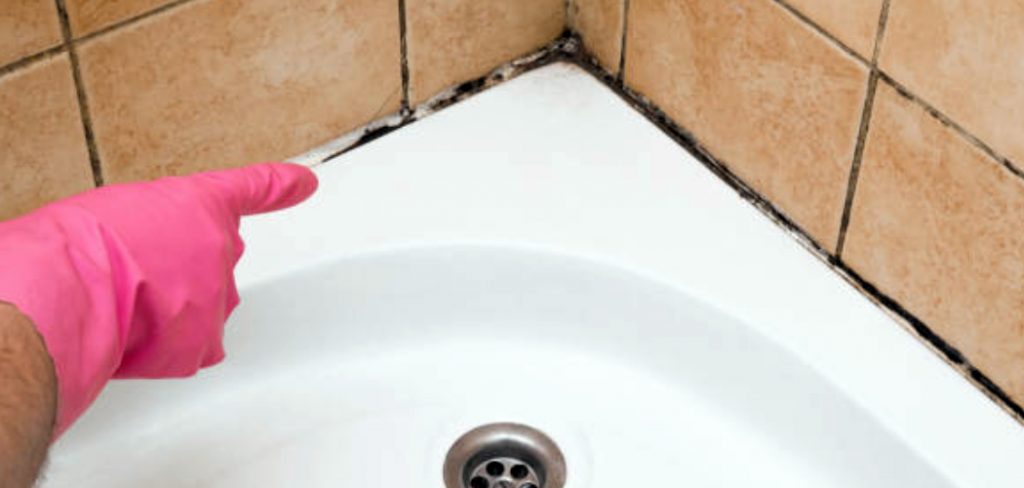
Condensation in bathrooms is a common issue that can lead to problems like mold growth, peeling paint, and an overall damp environment. It occurs when warm, moist air comes into contact with cooler surfaces, such as mirrors, windows, and walls. Preventing condensation is essential to maintaining a clean, healthy, and comfortable bathroom environment. Fortunately, there are effective methods to reduce or eliminate condensation, ensuring your bathroom remains fresh and free from excess moisture.
This guide on how to stop condensation in bathroom will explore practical solutions to tackle this issue and keep your bathroom in optimal condition.
What Are the Causes of Condensation in Bathrooms?
Before we dive into the methods to prevent condensation, it’s essential to understand why it occurs in the first place. The leading cause of condensation is moisture present in the air. When warm, humid air comes into contact with cool surfaces, such as walls and windows, it cools down and cannot hold as much water vapor. This excess water vapor then turns into droplets on these surfaces, forming condensation.
Other factors contributing to condensation include poor ventilation, lack of insulation, cold weather, and inadequate heating. These all create an environment where warm and moist air cannot escape, leading to higher humidity levels and ultimately causing condensation.
What Will You Need?
You will need a few basic items to implement the methods described in this guide. These include:
- A dehumidifier (if required)
- Towels or cloth for wiping surfaces
- Bathroom fan (if available)
- Silicone caulk
- Waterproof paint (optional)
Once you have these items on hand, you can begin tackling the condensation issue in your bathroom.
9 Easy Steps on How to Stop Condensation in Bathroom
Step 1: Ventilate the Bathroom

Proper ventilation is the first and most crucial step in reducing condensation in your bathroom. Ensure your bathroom has a functional extractor fan to help remove humid air during and after showers or baths. If your bathroom has no extractor fan, consider installing one, as it can significantly reduce moisture levels. Keep the bathroom door slightly open during and after use to promote airflow, especially with no windows. Open bathrooms with windows regularly to allow fresh air to circulate and push out the stale, moisture-laden air. Remember, even minor adjustments, like leaving the window ajar while taking a shower, can go a long way in minimizing humidity and preventing condensation buildup on walls, mirrors, and windows.
Step 2: Use a Dehumidifier
Using a dehumidifier can be a highly effective way to combat condensation in your bathroom. These devices are designed to extract excess moisture from the air, making the environment less conducive to mold growth and dampness. Portable dehumidifiers are particularly convenient, as they can be moved in and out of the bathroom. For smaller bathrooms, consider using a compact or wall-mounted dehumidifier to save space while still effectively reducing humidity. Regularly empty the water reservoir and clean the unit to ensure optimal performance. This simple addition can make a noticeable difference in maintaining a dry and comfortable bathroom.
Step 3: Improve Ventilation
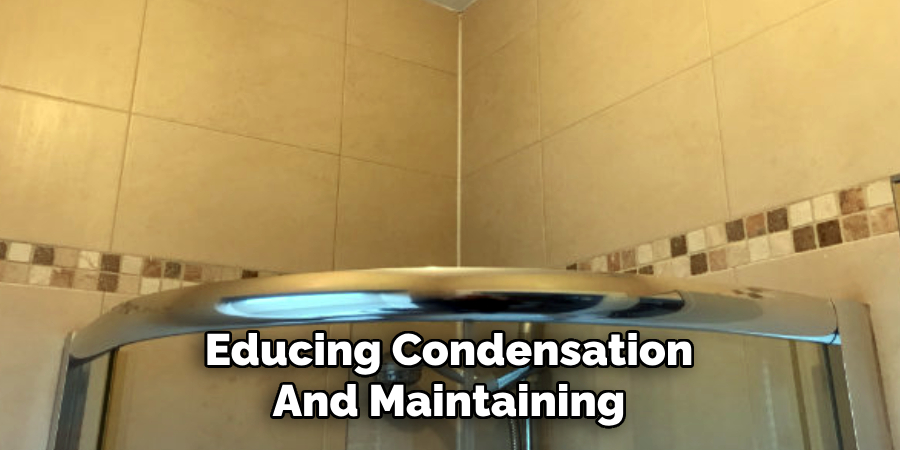
Proper ventilation is key to reducing condensation and maintaining a healthy bathroom environment. If your bathroom has no exhaust fan, consider installing one. An exhaust fan helps to expel moist air quickly, especially after hot showers or baths, preventing it from settling on surfaces. Ensure the fan is powerful enough for the size of your bathroom, and use it consistently whenever moisture is present. Additionally, clean the fan’s vents regularly to prevent blockages that can reduce its efficiency. By improving ventilation, you can significantly decrease the chances of condensation-related issues.
Step 4: Use Anti-Condensation Products
Anti-condensation products can be a practical solution to reduce moisture buildup in your bathroom. These products include anti-fog mirrors, condensation-resistant paints, and water-repellent sprays for windows and tiles. Anti-fog mirrors, for instance, are designed with a heated element that prevents steam from settling on the surface, ensuring clear visibility even after a hot shower. Condensation-resistant paints can help protect your walls by repelling moisture and preventing mold or mildew growth. Apply water-repellent sprays to glass surfaces to reduce the accumulation of water droplets, making them easier to clean. Incorporating these products into your bathroom can provide protection against damp conditions.
Step 5: Maintain a Consistent Room Temperature
Keeping a consistent temperature in your bathroom can help reduce the likelihood of condensation. Drastic temperature changes between the bathroom and adjacent rooms can cause moisture in the air to condense on surfaces, particularly during colder months. Using a small bathroom heater or ensuring that your central heating system maintains a steady temperature can help minimize these fluctuations. Additionally, insulating your bathroom walls and windows can prevent cold surfaces from promoting condensation.
Step 6: Keep Surfaces Dry
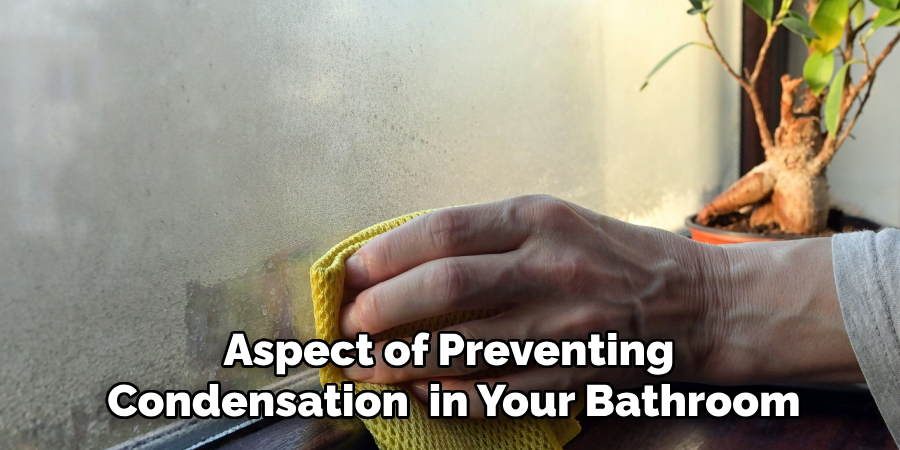
Keeping surfaces dry is an essential aspect of preventing condensation in your bathroom. After using the shower or bath, take a few minutes to wipe down walls, mirrors, and windows with a towel or cloth. This simple act can help remove excess moisture and prevent it from settling on these surfaces. You can also use a squeegee to quickly remove water droplets from larger surfaces such as shower doors. If you notice any water accumulating on the floor, use a mop or towel to soak it up promptly.
Step 7: Repair Leaks
Leaks in your bathroom can contribute significantly to persistent moisture problems, increasing condensation, and potentially more severe issues such as mold and structural damage. Regularly inspect your bathroom for leaks, including dripping faucets, running toilets, or water seeping from pipes, fixtures, or tiles. Pay close attention to commonly affected areas, such as under the sink, around the bathtub or shower, and near the toilet base. If you detect a leak, address it promptly by tightening fittings, replacing worn-out seals, or consulting a plumber for more complex repairs. Taking proactive steps to eliminate leaks helps control condensation, conserves water, and reduces your utility bill.
Step 8: Use Moisture-Absorbing Materials
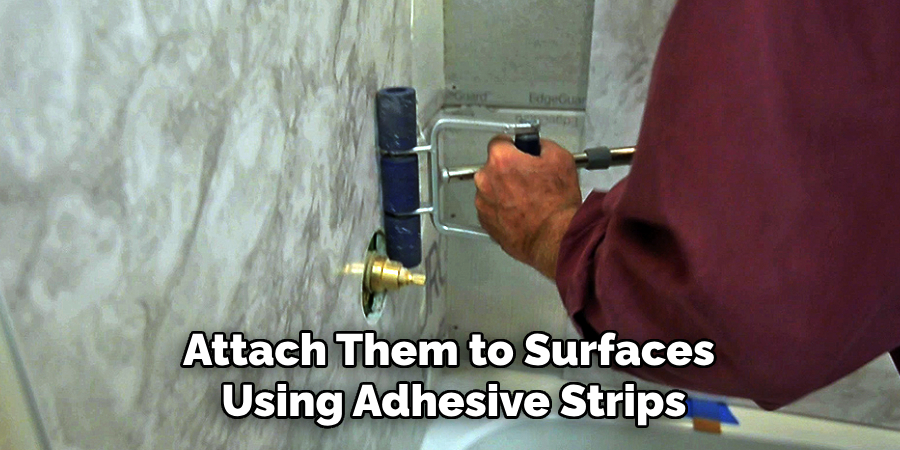
Incorporating moisture-absorbing materials into your bathroom can help reduce humidity levels and prevent condensation. Silica gel packets, for example, are commonly used in bathrooms to absorb excess moisture from the air. Place them in small containers around the toilet or attach them to surfaces using adhesive strips. You can also use bamboo charcoal ba, which have natural dehumidifying properties and can be reused in direct sunlight once a month. Other moisture-absorbing materials include rock salt, baking soda, and activated charcoal.
Step 9: Clean Regularly
Regular cleaning is crucial for maintaining a dry and healthy bathroom environment. Dirt and grime can trap moisture, increasing humidity levels and condensation. Clean your bathroom at least once a week, focusing on areas prone to accumulating water, such as the shower, bathtub, sink, and toilet. Use an anti-bacterial cleaner and ensure all surfaces are thoroughly dried after cleaning. Pay special attention to grout lines and corners where mold or mildew can easily grow.
By following these steps, you can effectively reduce condensation in your bathroom and prevent potential issues such as mold, mildew, and damage to your bathroom’s structure.
5 Things You Should Avoid
- Neglecting Ventilation: Failing to use or install proper ventilation, like an exhaust fan, can trap moisture, leading to persistent condensation issues. Always ensure your bathroom is well-ventilated.
- Skipping Regular Cleaning: Allowing dust and grime to build up on vents or windows hinders airflow, worsening condensation problems. Clean these surfaces regularly to ensure optimal performance.
- Ignoring Temperature Differences: Drastically changing bathroom temperatures, such as using hot water in a cold room, encourages condensation. Maintain a consistent room temperature to mitigate this.
- Using Non-Anti-Fog Products Using mirrors or glass surfaces without anti-fog coatings can lead to excessive moisture buildup. Consider switching to fog-resistant materials.
- Failing to Address Leaks – Overlooking small leaks in plumbing or around fixtures can introduce additional moisture, exacerbating the problem. Regularly inspect and repair leaks promptly.
How to Seal a Bathroom Fan?
Sealing a bathroom fan is essential in preventing moisture and condensation buildup. Here’s a simple guide on how to seal your bathroom fan:
- Turn off the Power: Before starting any work, turn off the power to your bathroom fan. You can do this by locating and switching off the circuit breaker that controls the fan.
- Remove the Fan Cover: Using a screwdriver, remove the screws holding the fan cover in place. Carefully take the cover off and set it aside.
- Clean and Inspect the Fan: Use a damp cloth to clean any dust or debris inside the fan. Take this opportunity to inspect it for any damage or signs of wear and tear.
- Seal Around Vent Pipe: Using caulk or foam insulation, seal around the vent pipe where it meets the ceiling or wall. This will prevent air from escaping and moisture from entering.
- Reattach Fan Cover: Once the sealant is dry, reattach the fan cover and secure it with screws.
- Turn on Power: Finally, turn the power back on to your bathroom fan and test it to ensure it’s working correctly.
Remember, proper ventilation is crucial in maintaining a healthy and moisture-free bathroom. Take the time to regularly clean and inspect your fan, and consider upgrading to anti-fog materials for added protection against condensation.
Conclusion
How to stop condensation in bathroom is essential to maintain a clean, comfortable, and mold-free environment.
You can effectively minimize moisture buildup by properly using ventilation systems like exhaust fans, ensuring seals around vents are tight, and keeping the room adequately heated. Regular cleaning and maintenance of your fan and using moisture-resistant paints or anti-fog treatments also add an extra layer of protection.
Incorporating these steps prevents condensation and prolongs the life of your bathroom materials and fixtures, ensuring a healthier and more pleasant space for everyday use.

